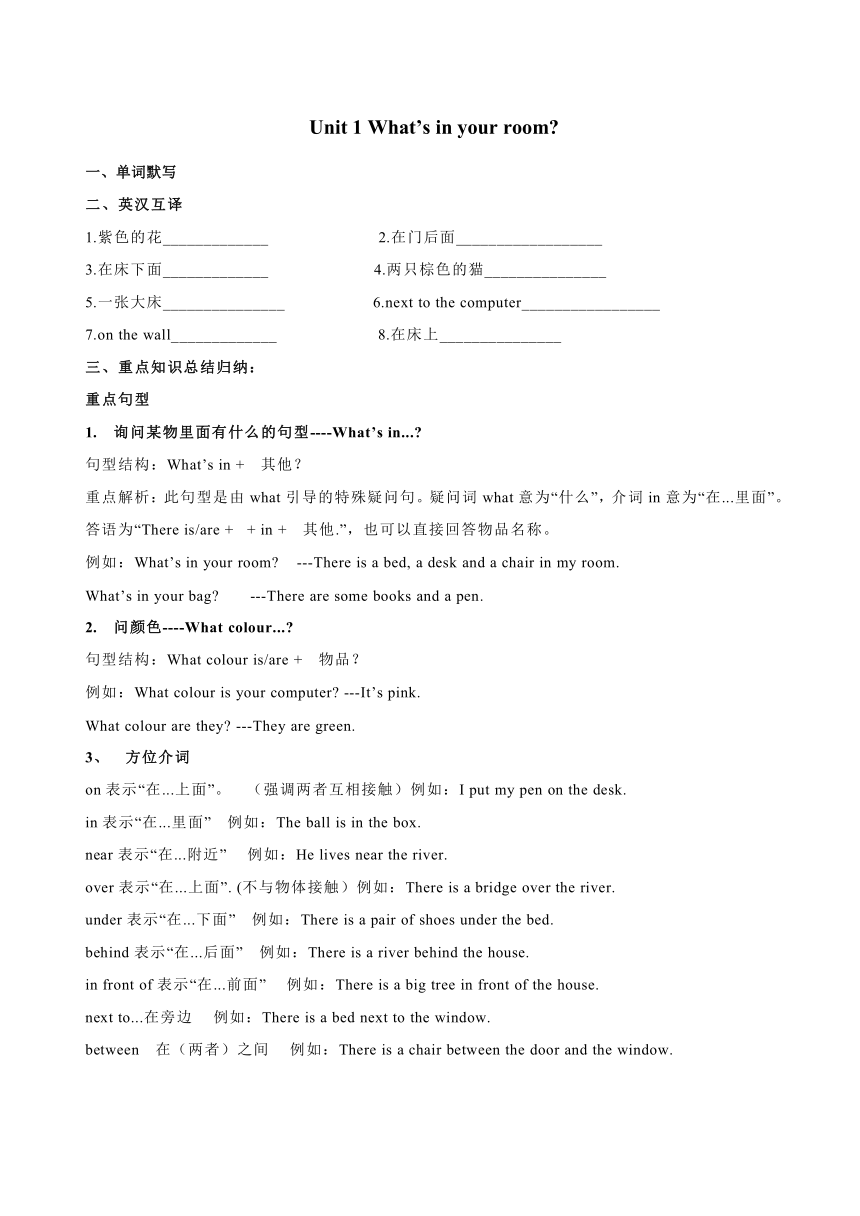
Unit 1 What’s in your room 一、单词默写 二、英汉互译 1.紫色的花_____ 2.在门后面_____ 3.在床下面_____ 4.两只棕色的猫_____ 5.一张大床_____ 6.next to the computer_____ 7.on the wall_____ 8.在床上_____ 三、重点知识总结归纳: 重点句型 1. 询问某物里面有什么的句型--What’s in... 句型结构:What’s in + 其他? 重点解析:此句型是由what引导的特殊疑问句。疑问词what意为“什么”,介词in意为“在...里面”。答语为“There is/are + + in + 其他.”,也可以直接回答物品名称。 例如:What’s in your room --There is a bed, a desk and a chair in my room. What’s in your bag --There are some books and a pen. 2. 问颜色--What colour... 句型结构:What colour is/are + 物品? 例如:What colour is your computer --It’s pink. What colour are they --They are green. 3、 方位介词 on表示“在...上面”。 (强调两者互相接触)例如:I put my pen on the desk. in表示“在...里面” 例如:The ball is in the box. near表示“在...附近” 例如:He lives near the river. over表示“在...上面”. (不与物体接触)例如:There is a bridge over the river. under表示“在...下面” 例如:There is a pair of shoes under the bed. behind表示“在...后面” 例如:There is a river behind the house. in front of表示“在...前面” 例如:There is a big tree in front of the house. next to...在旁边 例如:There is a bed next to the window. between 在(两者)之间 例如:There is a chair between the door and the window. 语法:be动词的用法和区别 1. there be句型和have/has的用法区别 be动词:am、 is、 are 口诀:我用am, 你用are, is用在他她它,复数全用are。 例题: (1) I_____ a boy. _____ you a boy No, I_____ not. (2) The girl_____ Jack's sister. (3) The dog _____ tall and fat. (4)The jeans _____ on the desk. 综合练习:用恰当的be动词填空。 1. The man with big eyes _____ a teacher. 2._____ your brother in the classroom 3. Where_____ your mother She _____ at home. 4. How_____ your father 5. Mike and Liu Tao _____ at school. 6. Whose dress _____ this 7. Whose socks _____ they 8. That_____ my red skirt. 9. Who_____ I 10. Here_____ a scarf for you. there be句型基本认识 1. 定义:There be句型表示某处存在某物或某人。 2. 结构: (1)There is +单数可数名词/不可数名词+ 地点状语. (2) There are +复数名词+地点状语. 注意事项: there是引导词,在句中不充当任何成分,翻译时也不必译出。句子的主语是某人或某物,谓语动词be要与主语(某人或某物)的数保持一致。当主语是两个或两个以上的名词时,谓语动词要与跟它最近的那个名词一致。 如:There is a bird in the tree. 树上有一只鸟。 There is a teacher and many students in our classroom. 我们教室里有一位老师和许多学生。 3. there be 句型的常考点 (1)变成否定 There be句型的否定式的构成和含有be动词的其它句型一样,在be后加上not即可。 例如: There are some pictures on the wall. 否: There is a bike behind the tree. 否: (2)变成一般疑问句 There be句型的一般疑问句变化是把be动词调整到句首,再在句尾加上问号即可。但同时要注意:当肯定句中有some时,要将其改为any(否定变化也一样)。 some 用于肯定句, any用于否定或疑问句。 There is some water on Mars. → (3)特殊疑问句 对主语提问:当主语是人的时候,则用who 引导,当主语是物的时候,则 ... ...
~~ 您好,已阅读到文档的结尾了 ~~

